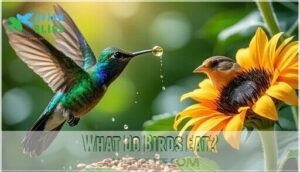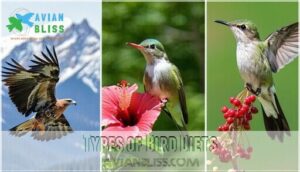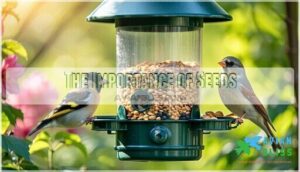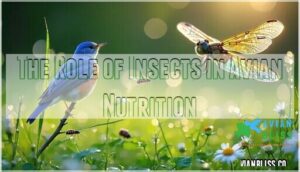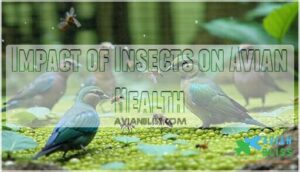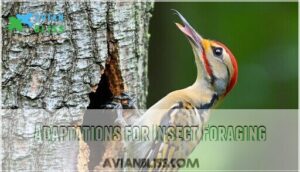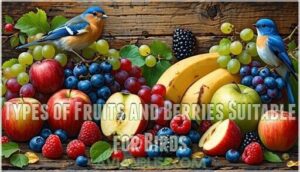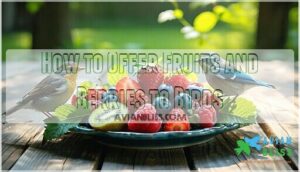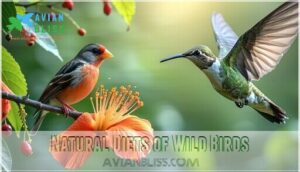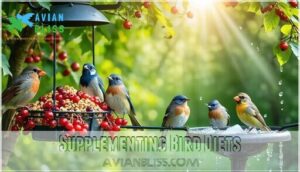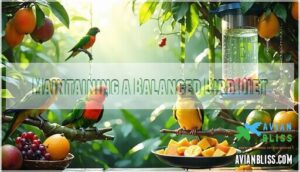This site is supported by our readers. We may earn a commission, at no cost to you, if you purchase through links.
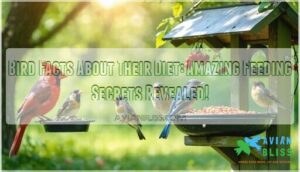
Some are seed connoisseurs, cracking shells like pros, while others, like hummingbirds, sip nectar as if nature handed them tiny straws.
Carnivorous birds, such as hawks, feast on meat, while omnivores mix it up with insects, fruits, and even fish.
Insects are a protein-packed favorite for many, and berries offer a sweet treat.
Human activity, like feeding birds at feeders, can shape their eating habits, sometimes for better or worse.
Curious about how birds’ diets influence their survival or how you can help? There’s plenty more to explore!
Table Of Contents
- Key Takeaways
- What Do Birds Eat?
- Types of Bird Diets
- The Importance of Seeds
- Insects in Bird Diets
- Fruits and Berries for Birds
- The Role of Nectar in Bird Diets
- Bird Feeding Habits
- Natural Diets of Wild Birds
- Supplementing Bird Diets
- Maintaining a Balanced Bird Diet
- Frequently Asked Questions (FAQs)
- What is the diet of a bird?
- How many meals do birds eat a day?
- How do birds eat food without teeth?
- What do birds eat the most?
- Do birds eat 10 times their weight?
- How many times do birds eat a day?
- What do birds do when they eat?
- How do birds forage for food?
- What factors influence birds dietary preferences?
- How do seasonal changes affect bird diets?
- Conclusion
Key Takeaways
- You’ll find birds eating seeds, insects, fruits, and nectar, with each species adapting their diet based on beak shape, habitat, and nutritional needs.
- Seasonal changes impact bird diets—winter calls for fat-rich seeds, while breeding seasons demand protein-packed insects.
- Human feeding habits can alter birds’ natural diets, so it’s better to offer native plants and clean feeders for healthier options.
- Avoid giving birds harmful human foods like bread or salty snacks; instead, provide safe, balanced options like seeds, fruits, and mealworms.
What Do Birds Eat?
You’ve probably watched birds at your feeder and wondered about their diverse eating habits, from tiny hummingbirds sipping nectar to cardinals cracking sunflower seeds.
Birds consume an impressive variety of foods including seeds, insects, fruits, nectar, and even small mammals, with each species adapting specialized feeding behaviors based on their beak shape, habitat, and nutritional needs, which is a key factor in their diverse eating habits.
Common Food Sources for Birds
Birds tap into nature’s buffet to fuel their high-energy lifestyles.
Your backyard visitors rely on three primary food sources that keep them thriving:
- Seeds and grains – from sunflowers to native grasses, providing essential fats and carbohydrates
- Garden insects and invertebrates – protein powerhouses for muscle development and feather health
- Wild berries and nectar – natural sugars for quick energy boosts
These common bird foods form the foundation of every bird diet, whether they’re seeking birdseed types at feeders or foraging naturally.
Importance of Varieties in Bird Diets
Like a well-stocked pantry, nutrient diversity fuels avian success across seasons.
You’ll notice healthier birds when they access varied food sources that meet their changing nutritional needs birds face throughout the year.
Dietary adaptations help species switch between protein-rich insects during breeding and energy-dense seeds in winter.
A truly balanced diet supports everything from feather development to immune function, making seasonal needs manageable for wild populations.
Birds’ diets are diverse, and some species even exhibit specialized feeding habits.
Foraging benefits multiply when birds can choose from multiple options rather than relying on single sources.
Human Impact on Bird Diets
How drastically are you changing your feathered friends’ lives? Your bird feeding creates significant behavioral changes in urban birds, shifting them away from natural diets.
While feeders provide convenience, they can increase disease transmission and create dependency on human food. Nutrient dispersal from bird feeders introduces significant amounts of phosphorus into local ecosystems.
Consider these impacts on urban bird diets:
- Feeder hygiene becomes critical as contaminated food spreads illness rapidly
- Food contamination from processed items disrupts their nutritional balance
- Native plants offer healthier alternatives than artificial feeding stations
Human impact reshapes entire ecosystems through our well-meaning interventions.
Types of Bird Diets
You’ll discover that birds fall into three main dietary categories based on what they consume: carnivorous species that hunt other animals, herbivorous birds that eat plants and fruits, and omnivorous species that enjoy both plant and animal matter.
Understanding these classifications helps explain why different birds have specialized beaks, hunting techniques, and feeding behaviors that match their specific nutritional needs.
Carnivorous Bird Diets
Understanding what birds eat brings us to nature’s most impressive hunters. Carnivorous birds dominate ecosystems through sophisticated hunting strategies and remarkable prey selection abilities. You’ll find these avian nutrition specialists have evolved incredible digestive adaptations to process whole animals, bones included.
Their bird diet varies dramatically based on habitat and opportunity:
- Hawks excel at catching small mammals with precision strikes
- Owls hunt silently using asymmetrical ear placement for perfect sound location
- Vultures display important scavenging behavior, cleaning up carrion efficiently
- Secretary birds stomp snakes to death with powerful legs
- Ospreys dive-bomb fish with specialized talons
A balanced diet is fundamental, so vitamin and mineral supplements can help prevent deficiencies. Understanding carnivorous birds helps you appreciate their essential conservation impact on balanced ecosystems.
Herbivorous Bird Diets
The gentle giants of the bird world have mastered plant-based living.
Herbivorous birds like swans and parrots showcase remarkable herbivore adaptations, from specialized beaks to unique digestion strategies.
You’ll spot them enjoying leafy greens, fruits, and seasonal greens throughout the year.
Some species even practice algae consumption, while their extended digestive systems efficiently extract nutrients from tough plant matter in their specialized bird diet.
Omnivorous Bird Diets
Omnivorous birds master survival through flexible dietary adaptations, switching between seeds, insects, fruits, and small prey.
Crows and jays exemplify this versatility, adjusting their foraging strategies based on seasonal changes and food availability.
Their adaptable bird diet helps them thrive in urban environments while meeting diverse nutritional needs.
You’ll notice these intelligent species exploring garbage cans, hunting invertebrates, and raiding berries with equal enthusiasm.
The Importance of Seeds
Seeds are a powerhouse of nutrition, offering birds essential proteins, healthy fats, and energy-packed carbohydrates.
By providing a variety of seeds, you can attract a diverse range of birds while supporting their health and natural feeding habits.
Nutritional Benefits of Seeds for Birds
Seeds serve as nature’s power-packed fuel stations for birds, delivering essential nutrients that keep our feathered friends thriving.
Nature’s tiny powerhouses fuel flight, song, and survival—seeds are the ultimate bird energy bars.
These nutritional powerhouses contain everything birds need for peak health and energy.
Key nutritional benefits seeds provide:
- Seed Carbohydrates supply instant energy for flight and daily activities
- Seed Proteins build strong muscles and support feather development
- Seed Fats provide concentrated calories for cold weather survival
- Seed Vitamins boost immune systems and overall bird health
- Seed Minerals strengthen bones and support essential body functions
Seed Varieties and Their Attraction to Birds
Different seed varieties attract specific birds like a magnet draws metal.
Sunflower seeds pull in cardinals, jays, and woodpeckers, while tiny goldfinches can’t resist Nyjer attraction.
You’ll spot chickadees choosing black oil sunflower over striped versions for their higher fat content.
Safflower benefits include deterring squirrels while attracting cardinals and woodpeckers.
Ground-feeding sparrows show strong millet preferences, pecking at scattered seeds below feeders.
Seed-eating birds demonstrate clear bird food preferences based on beak size and feeding habits.
Smart seed mixes combine multiple bird seed types, creating a buffet that satisfies various species’ nutritional needs and natural seed dispersal behaviors.
Many enjoy purchasing bulk seeds for convenience.
Importance of Offering a Variety of Seeds
Mixing up your seed varieties transforms your yard into a bird magnet that meets everyone’s needs.
Sunflower seeds attract cardinals, thistle draws finches, and millet brings sparrows running.
This seed diversity guarantees proper nutritional balance while supporting seasonal needs through different feeding strategies.
Each bird species has evolved specific preferences, so offering various bird seed types means you’re creating an inclusive buffet that keeps your feathered friends healthy year-round.
Insects in Bird Diets
You’ll discover that insects serve as protein powerhouses in bird diets, providing essential nutrients for muscle maintenance, feather development, and reproductive success.
Birds like swallows, woodpeckers, and flycatchers have evolved specialized adaptations, including wide mouths and long tongues, to efficiently capture these nutritious invertebrates throughout different seasons, which is crucial for their reproductive success.
The Role of Insects in Avian Nutrition
Insect protein fuels the avian world like high-octane gasoline powers race cars.
Insectivorous birds rely on this insect diversity for muscle development, feather health, and reproductive success.
Insect foraging behaviors vary dramatically – swallows catch flies mid-flight while nuthatches probe bark crevices.
Larval nutrition provides concentrated energy during breeding season.
Unfortunately, insecticides impact threatens these essential protein sources, disrupting natural bird diet patterns and insects and invertebrates availability.
Impact of Insects on Avian Health
Tiny insects pack a powerful punch for bird diet health.
Insect protein fuels feather development and supports breeding success in insectivorous birds.
However, insecticide effects disrupt gut microbiome balance, weakening immune systems and reducing chick survival rates.
These chemicals cause deformed embryos and smaller clutches.
Avian nutrition depends heavily on clean insect populations—when bug quality declines, so does overall bird health and reproductive success.
Adaptations for Insect Foraging
Through millions of years of evolution, insectivorous birds have developed remarkable beak adaptations and hunting strategies for successful insect foraging.
You’ll discover how bill morphology and tongue adaptations create perfect insect-catching tools, while enhanced sensory perception helps locate hidden prey.
- Woodpeckers use barbed tongues extending twice their head length to extract larvae from tree bark
- Flycatchers possess ultra-sensitive vision detecting insects from 50 feet away
- Swallows achieve digestive efficiency by catching soft-bodied insects requiring minimal energy to process
Fruits and Berries for Birds
You’ll discover that fruits and berries provide essential vitamins, antioxidants, and natural sugars that fuel birds like robins, cedar waxwings, and mockingbirds throughout their daily activities.
These colorful foods offer concentrated energy sources that help birds maintain their high metabolisms, especially during migration periods when they need extra calories for long-distance flights.
The Importance of Fruits and Berries in Bird Diets
You’ll discover that fruits and berries serve as nature’s premium fuel stations for countless bird species.
These colorful treats pack fruit sugars for instant energy, while berry antioxidants boost immune systems during stressful migrations.
Wild berries and orchard fruits become lifelines when insects grow scarce in winter months.
Frugivorous birds like robins and waxwings depend heavily on native berries for survival.
However, birds instinctively avoid toxic fruits that could harm them.
This natural bird diet component transforms ordinary backyards into bustling feeding grounds year-round.
Types of Fruits and Berries Suitable for Birds
Safe Fruits like apples, grapes, and bananas make excellent bird food choices for attracting diverse bird species to your yard.
Berry Nutrition comes naturally from blueberries, elderberries, and wild cherries that many birds crave. Garden Berries such as raspberries and blackberries provide essential vitamins and antioxidants.
However, avoid Toxic Berries like holly or yew, which can harm birds. Fruit Preparation matters too – remove pits from stone fruits and cut larger pieces into manageable sizes.
Your bird diet offerings should focus on variety and safety.
How to Offer Fruits and Berries to Birds
How can you turn your yard into a bird buffet with nature’s sweetest treats? Offering fresh, chopped fruits in shallow dishes creates an irresistible dining experience for your feathered visitors.
Here’s your bird feeding success plan:
- Remove harmful seeds and pits from all Safe Fruits before serving
- Clean feeders daily to prevent spoilage and maintain healthy bird food quality
- Place near natural shelter for comfortable Berry Preparation and consumption
Fresh beats frozen every time! For a balanced diet, remember that fruits offer essential nutrients.
The Role of Nectar in Bird Diets
You’ll discover that nectar serves as a concentrated energy source, providing the high-calorie fuel that hummingbirds and sunbirds need for their rapid wing beats and active lifestyles.
These specialized feeders have evolved unique adaptations, including long bills and extendable tongues, that allow them to access this sugar-rich liquid from deep within flowers.
Important Nutrition Facts for Nectar-Feeding Birds
Nectar-feeding birds live life in the fast lane, requiring constant refueling to power their high-energy lifestyle. You’ll find these aerial acrobats consuming sugar water solutions that contain 15-25% sugar concentration, providing immediate energy for their demanding metabolism.
Hummingbirds showcase the most specialized adaptations, with fork-tipped tongues designed for efficient nectar extraction.
- A hummingbird’s daily nectar intake can equal twice its body weight
- Nectar composition provides quick carbohydrate energy for sustained flight
- These birds create pollination benefits while meeting their energy requirements
Fun Facts About Nectar-Feeding Birds
Wonder fills the air when you watch hummingbirds and sunbirds navigate your garden like aerial acrobats.
These nectar-feeding birds possess extraordinary tongue morphology—grooved surfaces that capture liquid gold efficiently.
Their sugar preferences lean toward 20-25% concentration, mimicking natural nectar composition perfectly.
While providing pollination services, some engage in nectar robbing—sneaky side-holes that bypass flowers entirely.
These remarkable creatures visit 2,000 blossoms daily, making their bird diet incredibly specialized.
Figure-8 pattern
Bird Feeding Habits
You’ll discover that birds exhibit remarkably diverse feeding behaviors shaped by their high metabolism, specialized bills, and constant competition for resources.
Understanding these feeding habits reveals how environmental factors, seasonal changes, and human influence directly impact what, when, and how birds choose to eat, which is connected to their high metabolism.
Factors Influencing Bird Feeding Habits
Several key factors shape bird feeding behavior and their dietary habits.
Food availability drives where and when birds search for meals, while competition from other species forces them to adapt their strategies.
Habitat quality determines access to natural food sources, and physiological needs vary dramatically between breeding adults and growing chicks.
Climate change increasingly disrupts traditional bird feeding practices, forcing species to adjust their bird diet patterns.
You’ll observe these influences create unique feeding rhythms that change throughout the year, making each species’ approach distinctly different.
Types of Bird Feeders and Foods
Choosing the right bird feeders transforms your backyard into a bustling avian restaurant.
Different feeder types attract specific species—tube feeders work perfectly for finches, while platform feeders welcome ground-feeding birds like juncos.
Food variety matters too, from nyjer seeds to suet cakes.
Consider exploring various feeder designs to cater to different bird species.
Here are three essential bird feeding tips:
- Feeder placement should be near cover but away from predator hiding spots
- Hygiene practices require weekly cleaning with diluted bleach solution
- Seasonal foods like high-fat suet help birds survive harsh winters
Proper bird feeder types paired with quality bird food creates an irresistible dining experience.
Effects of Human-Supplied Foods
When you toss bread crumbs to pigeons, you’re inadvertently harming urban bird health.
Human food creates nutritional deficiencies and altered foraging behavior, making birds dependent on processed scraps instead of natural insects and seeds.
| Harmful Effects | Solutions |
|---|---|
| Bread dangers spread disease | Responsible feeding with proper seeds |
| Toxic treats cause malnutrition | Native plant growth supports natural diets |
| Leftovers risks disrupt ecosystems | Encourage natural bird diet behaviors |
Human-supplied food fundamentally changes how birds survive in urban environments.
Natural Diets of Wild Birds
You’ll discover that wild birds have evolved specialized diets based on their natural habitats, with species like finches cracking seeds, hummingbirds sipping nectar, and woodpeckers hunting insects beneath tree bark.
Understanding these natural feeding patterns helps you recognize how each bird’s beak shape, body size, and behavior perfectly match their preferred food sources in the wild, which is a result of their evolution to survive in their specific environments with unique feeding patterns.
Bird Nutrition Facts
How does proper avian nutrition impact wild bird health? Bird nutrition facts reveal that dietary needs mirror our own balanced approach. Wild birds require specific macronutrient balance and micronutrient importance for survival.
Seasonal changes dramatically alter their nutritional needs:
- Spring breeding demands extra protein for strong feathers
- Migration periods require high-calorie foods for energy storage
- Winter survival needs fat-rich seeds for warmth
Understanding bird diet essentials prevents food toxicity issues. High-energy foods are essential for winter survival. Bird nutrition knowledge helps you support local wildlife effectively.
Seed-Eating Birds
Seed preferences drive everything for these feathered gourmets.
You’ll notice finches favor thistle while cardinals crack sunflower seeds with their powerful beaks.
Beak morphology determines which bird seeds each species can handle—conical beaks crush tough shells, while slender bills pick smaller varieties.
Seed caching behavior helps chickadees survive winter by storing thousands of seeds in bark crevices.
Insects and Invertebrates in Bird Diets
Beyond the seed bowl, insects and invertebrates fuel your backyard birds with protein-packed nutrition.
These tiny powerhouses support muscle development and feather health, especially during breeding season.
Insectivore adaptations like specialized beaks help birds catch prey efficiently.
However, insecticide impacts threaten this essential bird food source.
Seasonal insect availability shapes insect foraging strategies, making avian nutrition fascinating to observe.
Supplementing Bird Diets
You can enhance your backyard birds’ natural diet by providing high-quality commercial bird foods that offer balanced nutrition and essential vitamins.
These supplemental foods help guarantee birds receive proper nutrients year-round, especially during harsh weather when natural food sources become scarce.
They are particularly important when the birds need balanced nutrition to thrive.
Benefits of Commercial Bird Foods
Commercial bird foods pack a nutritional punch that’ll keep your feathered visitors thriving year-round.
These specially formulated blends offer balanced nutrition and disease prevention benefits that wild foraging can’t always guarantee.
Here’s why they’re worth considering:
- Nutritional Completeness – Essential vitamins and minerals in every bite
- Convenient Feeding – No daily food prep required
- Year-Round Availability – Consistent nutrition regardless of season
- Bird Health – Supports immunity and overall wellness
Choosing The Best Bird Feed
Quality bird food starts with examining feed ingredients like black oil sunflower seeds and safflower.
Match feeder types to your target species – tube feeders for finches, platform feeders for cardinals.
Organic options cost more but offer cleaner nutrition, while budget options with mixed seeds attract diverse birds.
Consider specialty seed blends for superior nutrition.
Local sourcing guarantees freshness and supports regional wildlife needs effectively.
Incorporating Commercial Foods Into Your Bird’s Diet
Three steps can transform how you introduce commercial bird foods into your feathered friends’ routine.
Start by mixing small amounts with their favorite natural foods, gradually increasing the ratio over several weeks. This approach guarantees food safety while meeting bird nutritional needs without shocking their systems.
Choose types of bird food from companies practicing ethical sourcing and balanced nutrition. Remember, you’re supplementing wild diets, not replacing them entirely.
Avoiding dependence on commercial options keeps birds’ natural foraging instincts sharp. Think of bird food as a nutritional insurance policy—helpful backup, not the main event for your bird diet.
Maintaining a Balanced Bird Diet
You’ll discover that maintaining proper avian nutrition requires understanding which foods support bird health and which ones cause harm.
Creating the right dietary balance means providing essential nutrients while avoiding common household items that can seriously damage a bird’s digestive system and overall well-being.
This understanding is crucial for bird health, as it directly impacts the quality of life and longevity of the birds.
Avoiding Human Foods Harmful to Birds
Your backyard birds deserve better than yesterday’s leftover pizza.
Many human foods pose serious health risks to our feathered friends.
- Toxic foods like avocado, chocolate, and garlic can kill birds within hours
- Bread dangers include malnutrition and digestive blockages that cause suffering
- Salt toxicity from chips and crackers leads to kidney failure
Choose safe alternatives for responsible feeding instead.
Creating a Balanced and Nutritious Bird Diet
Building the perfect bird diet requires smart choices that match their seasonal needs.
You’ll want to offer diverse seed types, fresh fruits, and protein-rich insects throughout the year.
Dietary Balance prevents Nutritional Deficiencies while supporting peak health.
Consider Seasonal Foods like high-fat options during winter migrations.
Add Safe Treats sparingly, and maintain clean Water Sources nearby.
Your bird nutrition strategy should include multiple feeder types for complete bird dietary requirements.
Feeder Types
Frequently Asked Questions (FAQs)
What is the diet of a bird?
Birds eat a variety of foods based on their species—seeds, fruits, insects, nectar, or even small animals.
Their diets adapt seasonally, ensuring they get essential nutrients for energy, reproduction, and survival.
How many meals do birds eat a day?
Birds eat frequently, often snacking 5-10 times daily, depending on species and activity.
Their high metabolism demands constant fuel, so they’re like nature’s grazers, always pecking at seeds, insects, or fruits to stay energized.
How do birds eat food without teeth?
Imagine eating pizza with chopsticks—that’s how birds manage without teeth.
They use sharp beaks to grab food, then their gizzards (muscular stomachs) grind it up, often with swallowed grit acting like tiny teeth.
What do birds eat the most?
You’ll find birds munching on seeds, fruits, insects, and nectar the most, depending on their species.
Seeds are a universal favorite, while nectar fuels hummingbirds, and insects provide essential protein for many feathered friends, with seeds being a key favorite.
Do birds eat 10 times their weight?
Picture a tiny hummingbird sipping nectar—it doesn’t eat 10 times its weight daily, but it does consume about half its weight to fuel its high-energy lifestyle.
Most birds eat proportionally less than that.
How many times do birds eat a day?
Most birds eat several times a day due to their high metabolism.
They’re like tiny food machines, constantly refueling to stay active.
Frequency depends on species, food availability, and energy needs, especially during migration or breeding.
What do birds do when they eat?
When birds eat, they rely on their beaks to grab, crush, or tear food, often tilting their heads to swallow.
Some species store food in their crop, while others peck or sift through debris.
How do birds forage for food?
Foraging is like a treasure hunt—birds rely on sharp vision, specialized beaks, and instinct to locate food.
Whether probing soil, skimming water, or plucking berries, their strategies adapt to habitats and seasonal availability.
What factors influence birds dietary preferences?
A bird’s dietary preferences depend on its beak shape, habitat, and nutritional needs.
Seasonal changes, food availability, and life stages like migration or breeding also play key roles, influencing what and how they eat, with seasonal changes being a crucial factor.
How do seasonal changes affect bird diets?
When seasons shift, so do bird diets—like nature’s buffet resetting.
Migration demands high-calorie fruits and nectar, molting calls for protein-packed insects.
Winter pushes birds to munch on fat-rich seeds to survive frosty nights.
Conclusion
Ever wonder how bird facts about their diet reveal so much about survival and adaptation?
Birds thrive on diverse foods, from seeds and insects to fruits and nectar, each offering essential nutrients.
By understanding their diets, you can support local species with proper feeders, safe food choices, and habitat-friendly practices.
Avoid harmful human foods, and instead, offer a balanced variety to keep them healthy.
Small changes in your yard can make a big difference for feathered friends!

